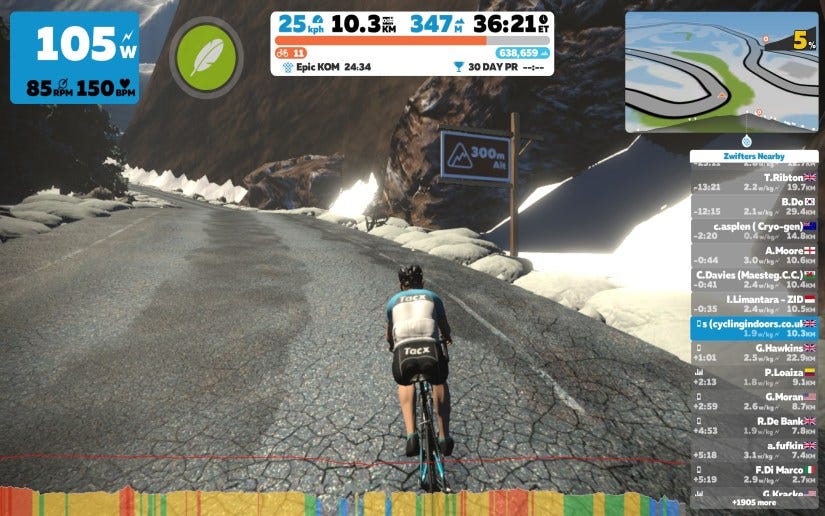Zwift - how a worldbuilder is breaking the dichotomy between exercise and gaming
Worldbuilder playbook, esports and the metaverse
Welcome to the first edition of the Techstadium. The Techstadium is a biweekly newsletter focused on the intersection of business strategy, sports, and Technology written by me - Max Riegel. You can find me here on Twitter. If you haven’t subscribed already, you can sign up here.
In this week’s edition, we’ll take an in-depth look at Zwift, one of the most exciting start-ups in the sports-tech sector. Zwift is especially intriguing because it builds a new and immersive experience for indoor cycling and thereby breaks the boundaries between exercise and gaming.
Let’s jump right in.
Finding an underserved market niche
After exiting his previous start-up, Sakonnet Technology, after nearly 15 years of work, Eric Min was looking for ideas for a new, category-defining start-up. He explicitly wanted to escape the cut-throat competition often seen in traditional businesses and searched for an opportunity to engage in world-building. During that time, Min, a passionate cyclist, read about an online game created by Jon Mayfield, an experienced video game graphics designer, on the Slowtwitch forum, a popular site for endurance athletes.
Mayfield, who started cycling in 2010, was left frustrated with the entertainment options available for indoor cycling trainers, which many endurance athletes rely on for parts of their training. Mayfield told the Red Bulletin reflecting on his initial frustration: “I spent five minutes on that thing trying to use Netflix — I couldn’t do it. [...] I assumed there’d be some game I could play with a trainer, but I looked, and there wasn’t anything good. So I started to program something for my own use.” After some iteration, Mayfield figured out how to translate pedal power into a video avatar riding down an animated road and shared his prototype for personal use online, which intrigued Eric Min.
An image from Mayfield’s early prototype (Source: Slowtwitch.com)
Min, who struggled to get outside on the bike due to family commitments and work, was doing the bulk of his workouts indoors and was convinced that the indoor cycling market was underserved as the experience hadn't changed for several years. Based on his interest in Mayfield’s prototype, Min arranged a meeting with Mayfield at his California home. Mayfield’s presentation took place in his spare bedroom, where he positioned his stationary bike in front of a monitor. Excited by the functioning prototype, Min offered Mayfield the opportunity to quit his job to fully commit himself to the opportunity to enhance the indoor cycling experience. In 2013, Mayfield and Min jointly incorporated Zwift with Scott Barger, a friend of Min and an enthusiastic cyclist, and Alarik Myrin, Min’s business partner from his time at Sakonnet Technology. After a year of further developing the initial prototype for commercial use, they launched a beta version of the product in September 2014. The market reception was phenomenal. The young start-up received 13.000 applicants for a beta launch that only offered 1.000 slots proving the inherent market demand for a superior indoor cycling experience. Thirteen months later, the product was launched to the public and has enjoyed explosive growth ever since. One year after the product launch, 100.000 cyclists had signed up for the service, including Facebook founder Mark Zuckerberg, former Paypal CTO Max Levchin, and Instagram co-founder Kevin Systrom. In 2018, the company passed 1.000.000 registered users.
As the COVID-19 pandemic has increased the reliance on indoor exercise, the market for cycling and bike training apps has received a further impetus for growth. Zwift more than doubled its registered user base to more than 2.500.000 registered users in the summer of 2020 (Zwift does not provide official numbers on the percentage of registered users that pay the 15 dollar-per-month subscription fee). Hence, it came as no surprise that Zwift recently made headlines after announcing a $450 million funding round led by KKR’s late-stage growth fund, which valued the company at over $1 billion, crowning it as another sports-tech unicorn. Additional backers include Permira, the Amazon Alexa Fund, Specialized Bicycle’s venture capital fund, and Zone 5 Ventures. Simultaneously, the earlier investors Highland Europe, Novator, Causeway Media, and True, reportedly also participated. In the context of the recent funding round, Stephen Shanley of KKR called Zwift the "preeminent" digital brand for cyclists and claims to see "tremendous potential ahead as Zwift invests further in its digital and physical products."
A cyclist working out on a dedicated indoor trainer using Zwift (Source: Zwift.com)
Given the recent buzz in the media and superior performance figures on similarweb compared to competitors like The Sufferfest, Kinomap, and Tacx, the next section aims to depict the underlying reason for Zwift’s growth and pathways to success in the future.
Applying the worldbuilder playbook to the indoor cycling market
In true world builder fashion (make sure to read Packy McCormick’s post on this topic), Zwift’s CEO Eric Min went after a small initial market, namely hardcore cyclists committed to the sport. The narrow customer segment served as an initial base for product iteration as hardcore cyclists can be considered a fairly demanding customer group. For its initial customers, Zwift built a software solution (initially available for Mac and Windows, but now also for iOS, Android, and AppleTV) that connects to a smart indoor turbo trainer. The software empowers users to ride with other cyclists in a virtual and gamified environment and share their performance statistics online. Against the backdrop of increasing bandwidth speeds and smart bike trainers' steady growth, Zwift’s training app found product-market-fit considerably early, demonstrated by the above-mentioned wide-ranging demand before the official product even launched.
Once Zwift locked in the small but very loyal customer group with its initial commercial product (more than one-third of the Tour de France participants are users of Zwift), the company started to expand its customer base. In this context, Min told Techcrunch in 2016: “I think people thought what we were doing was really niche, but we think the opportunity is very large. We’re going not just after traditional cyclists but anyone who wants to be more fit.” To fulfill this vision, Zwift combines elements from game design, social networking, and traditional indoor cycling training to build a genuinely immersive experience resulting in four key benefits that have spurred the company’s growth.
Firstly, Zwift makes indoor cycling fun. By incorporating several aspects of game design into the Zwift experience, the users can immerse themselves in an interactive, gaming-type setting. Cyclists can, for example, customize their avatar by choosing specific bikes and kits from their favorite real-world brands.
A user customizing its bike on the Zwift platform (Source: tri247.com)
Besides, the users can unlock new kits, biking equipment, or “power-ups” like a speed boost, as they exercise on the platform and are, therefore, incentivized to return for their next exercise frequently. Moreover, the users can unlock badges for several milestones, such as completing a 100 miles tour or hitting 1.000 watts in a sprint. The gamified aspects that increase the fun of the indoor cycling experience show no sign of slowing down, indicated by the fact that Ilkka Paananen, CEO of game maker Supercell, is joining Zwift’s board as part of the latest funding round. Considering Paananen’s pedigree, users can be excited to see how he will further contribute to Zwift’s development in the future. Besides, due to Zwift’s virtual cycling courses' vast depth, the riders can explore unseen sections of the map on a nearly ongoing basis. In this context, riders can also unlock new parts of the virtual map over time. For example, the Alpe d’Zwift, modeled after the famous Tour de France climb Alpe d’Huez, gets unlocked at level 12. In total, there are 25 levels to explore, which cyclists can progress through by cruising through virtual courses modeled after real-world cities like Innsbruck, London, New York, and Richmond, as well as Zwift’s internal creation, the island Watopia. These locations contain several different routes varying in distances, gradients, and scenery.
An example of Zwift’s virtual map of London (Source: Zwift.com)
However, as a single-player game would have a limited appeal to users in the age of Fortnite and Roblox, Zwift builds a social community around its gamified system by letting users ride with their friends, team members, and total strangers in group rides, workout mode, and during races. Compared to Peloton, which attracts its users’ interest primarily based on personality-focused and instructor-led studio-style spin classes, Zwift takes an orthogonal approach by building a community bottom-up centered around social interaction in a video game-like setting. Hence, Zwift’s users are not drawn to a particular instructor but to the idea of being part of a broad user base where they can train, take part in virtual events, and compete with one another. For this purpose, Zwift has built many dedicated features into its product, allowing users to join other riders while they are already on their route and providing an audio integration for riders to communicate with each other during their workout. As the desire for community and shared experiences increases, it comes as no surprise that several dedicated Zwift groups have gained a strong foothold, such as a group of dads that would otherwise be unable to work out with their friends. Besides, a broad community of Zwift live streamers has found a wide-ranging audience on YouTube while regularly racking up several hundred thousand views.
The example above highlights the broad interest in competitive racing on Zwift, which brings us to the third aspect of the company’s success: Zwift increases the competitive nature of indoor cycling. Zwift not only allows every athlete to precisely measure their performance, no matter their physical location. It also partnered with organizers of real-world cycling events to host virtual versions of the Giro d’Italia, the Vuelta a España, and the Tour de France. As the COVID-19 pandemic brought competitive outdoor cycling to a halt earlier this year, 117.000 riders participated in a virtual Tour de France earlier this summer. Casual cyclists could ride the same routes as the professionals and measure themselves against the world’s best or enjoy the event on television. Looking ahead, Zwift is well-positioned to build on these partnerships to create a genuinely immersive esports experience. The company’s CEO Eric Min sees this as a fundamental pillar for the company’s future development, saying that “as a legitimate esport, Zwift will be the first competitive athletic sport you can do from home.” Min even hopes that Zwift could become the first esport to get into the Olympics — maybe as soon as 2024.
A picture of the British indoor cycling championships hosted by Zwift (Source: Zwift.com)
For this purpose, the company must be incredibly rigid with its quality control regarding a user’s data input and their measurement accuracy. On this subject, the company’s technical co-founder John Mayfield declared in 2016: “There’s [...] real data behind all this. It’s not just a game. We measure everybody’s watts, their heart rate recorded, we have their cadence, the rate that they are pedaling the bicycle. We log it all to a real data file [...], and it also uploads to all the standard services like Strava.”
A user’s screen displaying the crucial performance data at the top (Source: cyclingindoors.co.uk)
This results in the final pillar of Zwift’s superior product offering, which spurred its growth. Zwift offers cyclists more control over their workouts. By eliminating the friction of riding outdoors, such as traffic lights, heavy wind, and rain, while also including real-time feedback on heat-rate, watts, and speed, Zwift makes it easier for riders to complete a set of intervals or long endurance rides. This is particularly important for users that work long hours and live in areas with limited access to the outdoors as Zwift offers the opportunity to work out independent of external circumstances in a controlled environment. In this context, the data processing capability that Zwift needs to be taken seriously in their attempt to become a force in esports also benefits their casual urban riders with interest in their performance progress over time.
Combining these four pillars, Zwift is positioned at the sweet spot of what Brett Bivens described as The Metaverse of Health, building on the Metaverse concept, outlined in detail by Matthew Ball. At its core, the metaverse idea is based on interoperability, the existence of a real-world connection, and virtual immersion. Zwift is located on the right side of the spectrum along all three dimensions.
Zwift takes an open approach towards data portability and interoperability, allowing its users to share their performance data across services.
Zwift blends the difference between the real-world and virtual world, demonstrated by the partnership with real-world race organizers.
Zwift offers its users a virtual immersion combining virtual and real-world elements by mirroring real-world cities in a virtual and gamified setting.
This hardly seems to be a coincidence given Min’s remark to Techcrunch in 2019, describing Zwift as a: “company born out of gaming. [But] [...] also a game and social network, two things that are converging rapidly right now.” As Zwift aims to fulfill its vision of creating a gamified and social experience for competitive and casual indoor sports, it builds substantial moats around its business. Most notably, Zwift is subject to network effects manifested in attracting more and more users, sponsorship partners, and event organizers in a mutually reinforcing cycle, which improves the experience for all parties. Besides, it has already built a strong brand for itself and has become synonymous with indoor cycling in some parts of the cycling community.
Upside potential in different verticals going forward
Though Cycling accounts for 98 percent of Zwift’s business at the moment, in the future, the company will likely further expand its offering into adjacent sports such as running and rowing. Given the already established playbook for growing in a specific vertical, I would not be surprised to see Zwift attracting a substantial user base in these verticals as well. In this context, it is crucial to consider that Zwift has already reached a scale that eases the growth in a different vertical, given its established brand and network. Besides, following the KKR investment, Zwift will reportedly start to produce its hardware - a smart trainer at first, and potentially a treadmill and a rowing machine at a later date. Most likely, the hardware will be sold nearly at cost or with a slight premium, as Zwift will primarily benefit if its software user base increases. Zwift should, therefore, consider its hardware as a way to ease the access to its software - and I am convinced that the people internally think similarly on this matter. I’m personally very bullish on the company's long-term prospects, and given the surge of SPACs and direct listings, I would not be surprised to see Zwift go public in some shape or form in the next couple of years. It is undoubtedly a company to watch out for, given its excellent strategic positioning based on Eric Min’s execution of the worldbuilder playbook, which positions Zwift as one the primary beneficiaries of the convergence of fitness and gaming.
If you enjoyed the article, please hit the like button, tell your friends about it or share it on social media. Besides, I highly appreciate your feedback in the comment section as well as on Twitter. See you next time!










Zwift is a great for indoor cycling and had many wonderful capabilities; but it does have some blind spots. When on any chosen route, it is not possible to check what route you are on [you have to remember it] , nor is it possible to display how far you have yet to cycle or how much climbing [elevation gain] remains.
Zwift is a great product! The best lockdown investment made, ever!